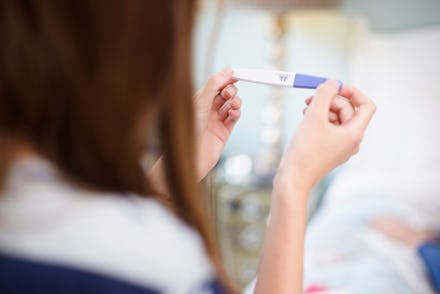Thanks to 'Teen Mom' and MTV, the Teen Birth Rate Is Now Lower Than Ever

Sex education in the United States is, in a word, an abomination. Only 22 states and Washington, D.C. require sex education to be taught in schools, and only 13 states require the information taught in these classes be "medically accurate." The end result is abstinence-only sex ed curricula rife with myths and misinformation, a teen STI rate that's higher than that of several western European countries and Yahoo! Answers threads from teenage boys asking how to "grow a condom."
But you know who's doing a great job teaching sex education? MT fuckin' V, that's who.
That's right: According to data from the National Center for Health Statistics, the teen pregnancy rate has dropped to a historical low, with the teen birth rate plummeting 9% from 2013 to 2014, to 24 births per 1,000 women ages 15 to 19.
Which is great news!
There is, however, a somewhat bizarre reason for this downward trend. It's not our sex education system that's contributing to lower birth rates. It's MTV shows like Teen Mom and 16 and Pregnant.
The pregnancy rate for 15- to 19-year-old girls has been steadily declining since 1991, with the teen childbirth rate decreasing by an impressive 61%. According to Bill Albert, a spokesperson for the National Campaign to Prevent Teen and Unplanned Pregnancy who spoke to BuzzFeed, one hypothesis has to do with the popularity of MTV shows like 16 and Pregnant and Teen Mom, which shine a spotlight on the grim reality of teen pregnancy.
"Young people tell us that these shows are far more sobering than salacious," Albert told BuzzFeed.
This isn't the first time that MTV has been linked to a decline in teen pregnancy rates. In 2014, the National Bureau of Economic Research determined that there was a 5.7% reduction in teen births in the 18 months following the premiere of MTV's 16 and Pregnant. While correlation does not equal causation, there might be a grain of truth to the idea that the show is scaring away teens from having unprotected sex.
That said, it's important to note that even though teen pregnancy might be on the decline, that doesn't mean that sex education in general has gotten any better. According to a recent Centers for Disease Control and Prevention report, a big percentage of U.S. schools fail in teaching students even basic information about condoms and safe sex. That's in part because, according to the Guttmacher Institute, 39 states still require that abstinence be included in sex ed curricula.
The link between abstinence-only sex education and higher teen pregnancy rates is well demonstrated, with a 2008 study determining that teens who received proper sex education were 60% less likely to get pregnant than teens enrolled in abstinence-only curricula.
Albert also credited a combination of abstinence and contraception use to the decreasing teen pregnancy rate. Yet there were seven states where the teen pregnancy rate has remained relatively unchanged over the past year: Alaska, Montana, Hawaii, Maine, Vermont, North Dakota and Wyoming. Five of these states have sex ed curricula that stress or cover abstinence, either alone or in tandem with contraception education, while Wyoming and Alaska do not require that sex ed be taught in schools at all.
Furthermore, teens might be getting pregnant less, but that doesn't necessarily mean they have the information or the resources needed to protect themselves from other risks. According to a 2014 CDC report, young people between the ages of 13 and 24 accounted for nearly a quarter of new HIV infections in the U.S. in 2010; almost half of the nearly 20 million STI cases reported in the United States each year are among people under the age of 24.
So yes, the teen birth rate is going down, and yes, shows like Teen Mom might have a little something to do with it. But let's not break out the champagne and celebrate just yet. When it comes to sex ed in America, we still have a lot of work to do.
h/t BuzzFeed